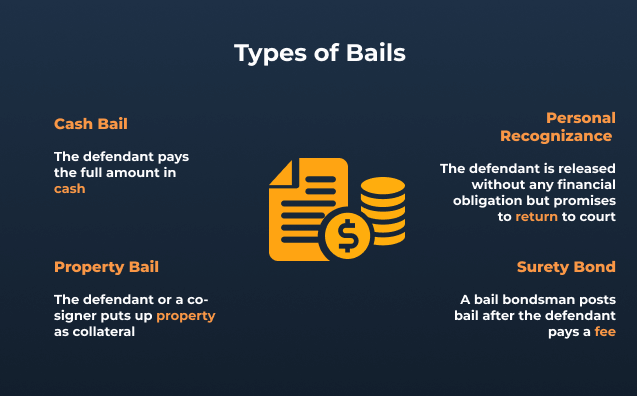When someone is arrested, they may be offered the opportunity to be released from custody while awaiting their court date through the posting of bail. However, not all bail is the same; different types of bail bonds are available, each suited to different situations. Understanding the distinctions between these types can help you navigate the legal process more effectively. Below, we explore the seven primary types of bail bonds.

1. Cash Bail
Overview
Cash bail is the most straightforward type of bail bond. The defendant, or someone on their behalf, pays the full bail amount in cash to the court. This payment serves as a guarantee that the defendant will appear at all required court dates.
When It’s Used
Cash bail is typically used when the bail amount is relatively low and the defendant or their family has the means to pay it outright. It’s often preferred because it doesn’t involve third parties, like bail bondsmen, and the money is returned if the defendant meets all court obligations.
Pros and Cons
- Pros: Simple, straightforward process; full refund (minus any fines or fees) if the defendant complies with court requirements.
- Cons: Requires a large upfront payment, which can be financially burdensome.
2. Surety Bond
Overview
A surety bond, often referred to as a bail bond, is used when the defendant or their family cannot afford to pay the full bail amount. In this case, they hire a bail bondsman who pays the bail on the defendant’s behalf for a fee, usually 10-15% of the total bail amount.
When It’s Used
Surety bonds are commonly used when the bail amount is high, and the defendant or their loved ones need assistance in covering the cost. It allows for the defendant’s release without having to pay the full bail amount upfront.
Pros and Cons
- Pros: More accessible for those who cannot afford cash bail; enables the defendant’s release even with limited financial resources.
- Cons: The fee paid to the bondsman is non-refundable, even if the defendant complies with all court orders.
3. Property Bond
Overview
A property bond allows a defendant to use their property as collateral to secure their release from jail. The court places a lien on the property, which is released once the defendant meets all court requirements. If the defendant fails to appear in court, the court may foreclose on the property to cover the bail amount.
When It’s Used
Property bonds are typically used when cash bail is not an option, and the defendant or their family owns real estate with sufficient equity to cover the bail amount. This type of bond is more complex and involves a detailed appraisal process.
Pros and Cons
- Pros: Allows for bail without cash; can be used to secure large bail amounts.
- Cons: Lengthy and complex process; risk of losing property if the defendant fails to appear in court.
4. Release on Own Recognizance (OR)
Overview
Release on Own Recognizance (OR) is a type of bail where the defendant is released from custody without having to pay any bail money. Instead, they sign an agreement to appear in court on their scheduled dates. This type of release is granted at the judge’s discretion, usually for defendants who pose little flight risk and are facing minor charges.
When It’s Used
OR is typically used in cases involving first-time offenders, minor crimes, or when the defendant has strong ties to the community. The judge must be confident that the defendant will return to court without the incentive of a financial bond.
Pros and Cons
- Pros: No financial burden; quick release.
- Cons: Not available to everyone; depends on the judge’s assessment of the defendant’s risk.
7 Types of Bail Bonds
5. Immigration Bond
Overview
An immigration bond is a type of bail bond used for individuals detained by immigration authorities. This bond allows the release of a detainee while they await their immigration hearing. Immigration bonds are more complex than other types of bail bonds and often require a higher premium due to the risk of the detainee fleeing the country.
When It’s Used
Immigration bonds are used specifically in immigration-related cases, where the detainee needs to be released while their case is processed. These bonds are handled by immigration courts rather than criminal courts.
Pros and Cons
- Pros: Allows the detainee to remain free while awaiting their hearing; can be posted by family members or friends.
- Cons: Higher cost due to the perceived risk; more complicated process involving immigration law.
6. Federal Bond
Overview
A federal bond is used for defendants facing federal charges. Because federal cases are often more serious, involving complex legal issues, the bail amounts are typically higher, and the bond process is more stringent. Federal bonds can be cash bonds, surety bonds, or property bonds, depending on the court’s requirements.
When It’s Used
Federal bonds are used when a defendant is charged with a federal crime and needs to be released while awaiting trial. These bonds are governed by federal laws and are subject to stricter regulations than state or local bail bonds.
Pros and Cons
- Pros: Allows for release in federal cases; can involve different types of bonds depending on the circumstances.
- Cons: Higher costs and stricter conditions; more complex legal requirements.

7. Citation Release (Citation in Lieu of Bail)
Overview
A citation release, or citation in lieu of bail, is issued by law enforcement officers for minor offenses. Instead of being taken into custody, the individual receives a citation (a written notice) with a date to appear in court. No bail money is required for this type of release.
When It’s Used
Citation releases are typically used for minor infractions or misdemeanors where the individual poses little to no risk of failing to appear in court. This option is often used for traffic violations and other non-violent offenses.
Pros and Cons
- Pros: No financial requirement; avoids the hassle of being booked into jail.
- Cons: Only available for minor offenses; failure to appear can result in additional charges.
Conclusion
Understanding the different types of bail bonds is essential for navigating the legal system, whether you’re a defendant, a loved one, or simply seeking knowledge. Each type of bail bond serves a specific purpose and comes with its own set of advantages and disadvantages. By familiarizing yourself with these options, you can make informed decisions that best suit your situation and ensure that the legal process is as smooth and manageable as possible.

